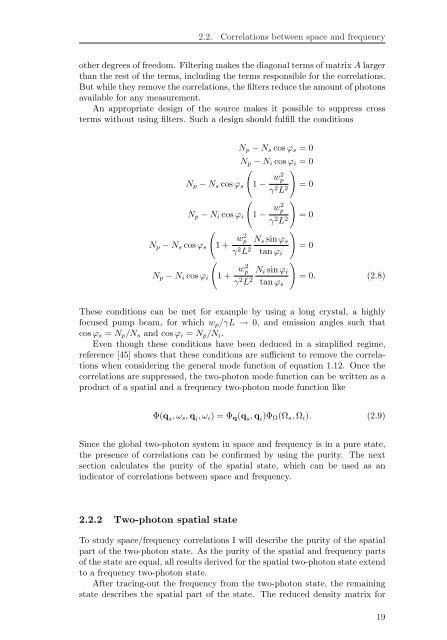Spatial Characterization Of Two-Photon States - GAP-Optique
Spatial Characterization Of Two-Photon States - GAP-Optique
Spatial Characterization Of Two-Photon States - GAP-Optique
You also want an ePaper? Increase the reach of your titles
YUMPU automatically turns print PDFs into web optimized ePapers that Google loves.
2.2. Correlations between space and frequency<br />
other degrees of freedom. Filtering makes the diagonal terms of matrix A larger<br />
than the rest of the terms, including the terms responsible for the correlations.<br />
But while they remove the correlations, the filters reduce the amount of photons<br />
available for any measurement.<br />
An appropriate design of the source makes it possible to suppress cross<br />
terms without using filters. Such a design should fulfill the conditions<br />
Np − Ns cos ϕs<br />
Np − Ni cos ϕi<br />
Np − Ns cos ϕs<br />
Np − Ni cos ϕi<br />
<br />
<br />
Np − Ns cos ϕs = 0<br />
Np − Ni cos ϕi = 0<br />
<br />
<br />
1 + w2 p<br />
γ2L2 1 + w2 p<br />
γ 2 L 2<br />
1 − w2 p<br />
γ 2 L 2<br />
1 − w2 p<br />
γ 2 L 2<br />
Ns sin ϕs<br />
tan ϕi<br />
Ni sin ϕi<br />
tan ϕs<br />
<br />
<br />
<br />
= 0<br />
= 0<br />
= 0<br />
= 0. (2.8)<br />
These conditions can be met for example by using a long crystal, a highly<br />
focused pump beam, for which wp/γL → 0, and emission angles such that<br />
cos ϕs = Np/Ns and cos ϕi = Np/Ni.<br />
Even though these conditions have been deduced in a simplified regime,<br />
reference [45] shows that these conditions are sufficient to remove the correlations<br />
when considering the general mode function of equation 1.12. Once the<br />
correlations are suppressed, the two-photon mode function can be written as a<br />
product of a spatial and a frequency two-photon mode function like<br />
Φ(q s, ωs, q i, ωi) = Φq(q s, q i)ΦΩ(Ωs, Ωi). (2.9)<br />
Since the global two-photon system in space and frequency is in a pure state,<br />
the presence of correlations can be confirmed by using the purity. The next<br />
section calculates the purity of the spatial state, which can be used as an<br />
indicator of correlations between space and frequency.<br />
2.2.2 <strong>Two</strong>-photon spatial state<br />
To study space/frequency correlations I will describe the purity of the spatial<br />
part of the two-photon state. As the purity of the spatial and frequency parts<br />
of the state are equal, all results derived for the spatial two-photon state extend<br />
to a frequency two-photon state.<br />
After tracing-out the frequency from the two-photon state, the remaining<br />
state describes the spatial part of the state. The reduced density matrix for<br />
19



